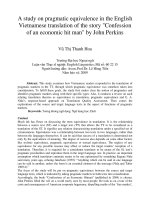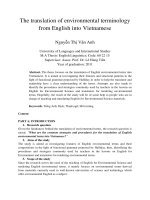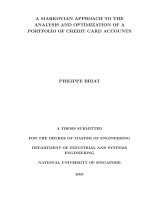TRANSLATION OF TERMINOLOGY ON CREDIT CARD
Bạn đang xem bản rút gọn của tài liệu. Xem và tải ngay bản đầy đủ của tài liệu tại đây (186.57 KB, 27 trang )
English-Vietnamese translation of terminology on credit card
- 19 -
CHAPTER THREE: TRANSLATION OF TERMINOLOGY ON
CREDIT CARD
Section A: An overview of credit card and credit card terminology
1. An overview of credit card
1.1. The definition of credit card and its operation
• What is credit card?
Credit card is small card, usually made of plastics, containing a means of
identification, such as a signature or picture, that authorizes the person named on
it to charge goods or services to his account, on which he is billed periodically.
• How does it work?
A user is issued a credit card after an account has been approved by the
credit provider (often a general bank, but sometimes a captive bank created to
issue a particular brand of credit card, such as American Express Centurion
Bank), with which they will be able to make purchases from merchants (cơ sở
chấp nhận thẻ) accepting that credit card up to a pre-established credit limit (hạn
mức tín dụng)
When a purchase is made, the credit card user agrees to pay the card
issuer. Originally the user would indicate his/her consent to pay, by signing a
receipt with a record of the card details and indicating the amount to be paid, but
many merchants now accept verbal authorizations via telephone and electronic
authorization using the internet.
English-Vietnamese translation of terminology on credit card
- 20 -
Electronic verification systems allow merchants (using a strip of
magnetized material on the card holding information in a similar manner to
magnetic tape or a floppy disk) to verify that the card is valid and the credit card
customer has sufficient credit to cover the purchase in a few seconds, allowing
the verification to happen at time of purchase. Other variations of verification
systems are used by ecommerce merchants to determine if the user's account is
valid and able to accept the charge.
Each month, the credit card user is sent a statement indicating the
purchases undertaken with the card, and the total amount owed. The cardholder
must then pay a minimum proportion of the bill by a due date, and may choose
to pay the entire amount owed or more. The credit provider charges interest on
the amount owed (typically at a much higher rate than most other forms of
debt). Some financial institutions can arrange for automatic payments to be
deducted from the user's accounts.
Credit card issuers usually waive interest charges if the balance is paid in
full each month, but typically will charge full interest on the entire outstanding
balance from the date of each purchase if the total balance is not paid.
1.2. The birth and development of credit card
• The birth of credit card
The concept of paying merchants using a card was invented in 1950 by
Ralph Schneider and Frank X. McNamara in order to consolidate multiple cards.
The Diners Club produced the first "general purpose" charge card, which is
similar but required the entire bill to be paid with each statement. In 1950, the
first Diners Club cards were given out to 200 associates of McNamara, mostly
salesmen who often needed to dine with clients. At that time, Diners Club had
English-Vietnamese translation of terminology on credit card
- 21 -
signed up 14 restaurants in New York City. Membership grew quickly as both
new customers applied for the card and more restaurants signed on. By the end
of 1950, Diners Club had 20,000 customers and was accepted at over 1000
restaurants.
• The development of credit card
The new way of payment quickly appealed to people and increasingly
improved and developed. Diners Club cards were followed shortly thereafter by
American Express, Western Union, Trip Charge, Golden Key, Gourmet Club,
Esquire Club, etc. At this time, most of cards were intended for business circle,
however, issuers soon got to know that individual from middle class should be
targeted. Then came the introduction of the biggest credit card issuers
nowadays: Visa and Master Card. Bank of America created the BankAmericard
in 1958, a product which eventually evolved into the Visa system ("Chargex"
also became Visa). MasterCard came to being in 1966 when a group of credit-
issuing banks established MasterCharge.
There are now countless variations on the basic concept of revolving
credit for individuals (as issued by banks and honored by a network of financial
institutions), including organization-branded credit cards, corporate-user credit
cards, store cards and so on.
1.3. Types of credit cards
Credit cards are diversified in type. Credit card can be classified into five
major types according to its production technology, issuer, payment
characteristics, geographical distribution, and cardholders.
English-Vietnamese translation of terminology on credit card
- 22 -
• In terms of production technology, there are three main type:
- Embossing card (thẻ khắc chữ nổi): credit cards in it early days
were produced by this method. However, such technology that
was easy to imitate has become quickly obsolete.
- Magnetic stripe (thẻ băng từ): is employed with two magnetic
stripes on the back of the card and has been in use for the past 20
years. However, the technology has revealed quite a few
weaknesses.
- Smart card (thẻ vi mạch): is the latest advance of credit card
having the same characteristics with a complete computer.
• With regard to the issuer of credit cards, we have two types:
- Credit cards issued by Banks (Visa Card, Master Card)
- Credit cards issued by non-bank institutions (cards of giant
businesses, economic groups like Diner’s Club card)
• Considering payment characteristics, there are 3 types:
- Credit cards: the most popular one that allows users to
purchase goods, services within a credit limit granted by the
issuer. In other words, users spend without paying in advance.
- Debit cards: cardholders must have a bank account to secure
their spending. In fact, they are an alternative for cash. There are
online and offline debit cards.
- Cash cards: are cards used to withdraw money at ATMs or at
banks. Users are required to deposit money at banks or have
overdraft account.
English-Vietnamese translation of terminology on credit card
- 23 -
• Based on geographical distribution, there are two types:
- Domestic credit card: issued and used within one country only.
Transaction currency is the local money.
- International credit card: is accepted worldwide and
transactions are carried out by hard currencies.
• On the basis of cardholder classification:
- Individual cards: are cards for individual cardholder and use
- Corporate cards: Its cardholders are companies, organizations
2. Credit card industry of Vietnam
Credit card, a payment measure free of cash has been popular and
favoured all over the world, accounting for 15-22% profits of banks in
developed and industrialized countries. However, in Vietnam, such product
remains new and the use of credit card is confined to some groups of people
only.
Since the Doi Moi (Renewal) policy was initiated in Vietnam, the banking
system has been renovated rapidly with new banking products and services
developed in line with the economic growth of the country. In 1990, for the first
time, Bank for Foreign Trade of Vietnam (Vietcombank) became the settlement
banks for VisaCard. In 1991, under the agreement between Vietcombank and
Malaysia Banking and Finance Institution, Mastercard was officially accepted
in Vietnam. Later, JCB, a Japan-originated credit card, Amex credit card of
American Express also presented in the country.
English-Vietnamese translation of terminology on credit card
- 24 -
The Vietnam’s credit card market really grew vigorous and boisterous in
1995. In addition to Vietcombank, another nine banks also went in the credit
card
business, namely ACB, First Vina, Sacombank, ANZ, Eximbank, Hongkong
bank, etc. In 1996, Vietcombank became the member of VISACARD and
MASTERCARD, and acted as the issuing bank of the two world-leading credit
card organizations. Currently some other banks are also chosen to issue and
settle international cards like ACB and VIBank. Besides, almost all commercial
banks in Vietnam offer their customers domestic cards that are in use within
Vietnam territory to purchase goods and services or withdraw cash.
Thanks to the national economic stable growth, the wave of tourism,
foreign investment to Vietnam, Vietnam’s credit card industry will surely grow
considerably in years to come.
3. Credit card terminology overview.
Credit card is a banking product; however, its terminology is not purely
related to the scope of banking and finance. In fact, terms on credit card have a
close relation with Information and Telecommunication Technology, or
technologies facilitating the issuing and usage of credit card itself. It is the
reason why credit card term translation is quite different from that of terms on
Banking and Finance in general.
In terms of lexical construction, the credit card terminology indexed in last
pages of the Paper is comprised by:
1. single words
2. shortenings
3. word groups or phrases:
English-Vietnamese translation of terminology on credit card
- 25 -
• phrases contain derived words
• phrases contain shortenings
Comparison between English and Vietnamese version of credit
terminology has revealed that Literal translation is favoured other than
Communicative translation to render source-language terms into target language
ones. It is also found that non-equivalent terms are dealt with by methods
including paraphrase, transference, connotative and denotative equivalence, and
implicit and explicit components of lexical items. Besides, the use of Sino-
Vietnamese factor in the translation of listed credit card terms is employed
widely and successfully. Each translation method will be analyzed quite
profoundly as follows.
English-Vietnamese translation of terminology on credit card
- 26 -
Section B: Translation of credit card terminology
It should be noted that the set of terms on credit card used in this
Graduation Paper are selected from the English-Vietnamese dictionary of
economics and business by Nguyễn Đức Dy and Hồ Ngọc Bích and English-
Vietnamese dictionary on Commerce, Finance and Banking by Nguyễn Thi Ái
Nguyệt and Nguyễn Tùng Lâm. Besides, some terms are retrieved from the
Internet, collected from reference books, publications of banks, professional
Journals by the Paper’s writer and then edited by bankers who are from Card
Department of different banks namely Vietcombank, Banknet, Agribank and
BIDV. These terms are widely accepted among bankers and cardholders as well
as their readers. The comparison between the source language and translated
version of credit card terminology will reveal the methods applied to produce
the final and accurate Vietnamese equivalents, which will be presented hereby.
1. The application of Literal and Communicative translation
It is easily recognized that Literal translation dominates the translation of
credit card terminology. According to Peter Newmark, Literal translation ranges
from one word to one word, group to group, collocation to collocation, clause to
clause, to sentence to sentence, and that it ensures an one-to-one relationship
between originals and translated versions. Therefore, most translators rely on
this method to bring about the most satisfactory equivalents.
Examples:
Account Number : Số tài khoản
Complaint Fee : Phí khiếu nại
English-Vietnamese translation of terminology on credit card
- 27 -
Customer Code : Mã khách hàng
Data Protection Method : Phương pháp bảo vệ dữ liệu
Credit Limit : Hạn mức tín dụng
Credit insurance : Bảo hiểm tín dụng
Digital Signature : Chữ ký kỹ thuật số
Expired Card : Thẻ hết hạn
Gold card : Thẻ vàng
Lost Card Fee : Phí thất lạc thẻ
Silver card : Thẻ Bạc
Virtual Account : Tài khoản ảo
Settlement Date : Ngày thanh toán
All Vietnamese equivalents terms transposed by this method are
intelligible and accordingly logical to the relevant background knowledge.
Furthermore, they are up to the norm of accuracy required by terminology in
general. One word in the source language corresponds semantically, e.g. Digital
Wallet=Ví điện tử. People who may work or be interested in the field of credit
card can easily accept that the Vietnamese equivalents are of great simplicity
and understandability.
The method of Literal translation is preferred in the translation of credit
card terminology in this case due to the following reason:
English-Vietnamese translation of terminology on credit card
- 28 -
• Normally, terms are considered context-free and within one specialized
field, one term keeps its own meaning in whichever contexts it stands. In
fact, the more specific or technical a word is, the less it is likely to be
affected by the context.
• Terms bear no characteristics of the synonym and polysemy.
Nevertheless, this rule only applies in the case of one specialized field
because there still exist polysemy terms in fields of different professions.
For instance, “clearing” in forestry is defined as an open space in a forest
where there are no trees. Its Vietnamese word is “khoảng rừng trống”. But
“clearing” in “Automated Clearing House Payment” in the field of credit
card in Vietnamese means “thanh toán bù trừ tự động”
• Original terms and their counterparts are equivalent in terms of the
referent and pragmatic effect.
• Word alienisms and neologism are rarely found
Though Literal method proves to be useful in the translation of
terminology, it is adopted when terms are translated singly, out of context or the
source language term and its equivalents in the target language keeps a
corresponding relation. Often, terms are translated directly based on its nearest
original meaning. However, there are terms whose meaning could only be
transposed based on the context they appear in and of the specialized knowledge
that the translators possess.









